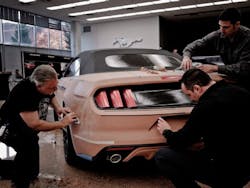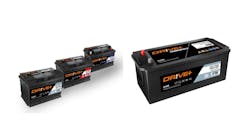Clay modeling training can lead to a lucrative automotive career
Getting your hands dirty during the automotive design stage may not seem like a likely occurrence, yet it remains quite common as clay modelers continue to ply their art form despite ongoing advances in computerized engineering technology.
“That’s a misconception that a lot of people have,” sasys Mark Trostle, chief of automotive design at Roush Industries. “Clay is very much a useful tool. Everyone in the industry wants to see what a design looks like in 3D before signing off on it.”
Giuliano Zuccato, one of six clay design modelers who took part in crafting the original 1964 Mustang, attracted a lot of attention and inspiration in Las Vegas this past fall, giving a keynote address at the Audio-Video Inc. (AVI) Conference and signing autographs at Bartec’s AAPEX booth.
With many experienced clay modelers now nearing retirement age, steady hands and a bit of artistic talent – combined with the proper training – can lead to a lucrative creative career. An auto clay modeler’s annual salary averages $81,474 in the U.S., with some pulling in nearly $140,000 per year.
“The automotive design studios will continue to have a need for talented clay modelers. Many design schools that teach industrial/automotive design also offer specific clay modeling programs,” says Roush’s Trostle. “Many younger clay modelers are also being trained in digital sculpting and clay mill programming as the need continues to grow.”
A good candidate for clay training is “an individual who can visualize in 3-dimension, understands surface development, and has an ability to interpret a 2D sketch or rendering into 3D,” he reports. “Engineering knowledge is not as important. A sense of aesthetics, scale and surface development are very important.”
Clay modeling perfects appearance-related items such as exterior fascias, spoilers, air intakes, splitters, lower body add-ons and certain interior components like center consoles and instrument panels. “It can be used as a model to pull a mold from for fabricating a composite hard part,” says Trostle.
“Clay can be easily modified or used to create an alternative design solution. These changes can be captured with a scanning device and quickly fed back to the computer to be implemented or studied,” he says. “A finished clay model can be painted or covered in a vinyl film to give the appearance of a finished product, and clay models are also used by the OEMs for wind tunnel studies and real-time surface changes to improve aerodynamics.”
Roush has five full-time clay modelers. General Motors employs about 400 clay and digital sculptors at its technical center in Warren, Mich. along with additional skilled personnel at its North Hollywood, Calif. design studio and several other facilities around the world. In Michigan alone GM hires at least 20 clay and digital sculptors each year. Ford currently employs between 100 and 200 modelers, including both physical and digital modeling pros.
Not an outmoded art
“The pendulum has swung back and settled into a hybrid of digital and clay modeling,” says Ford modeling manager Lloyd VandenBrink. “Some things are better if they are done digitally. Others are better if they are done with clay. We are constantly being influenced by new technologies, but when we want to view physical properties early in the process, we still turn to clay. When a design is still fluid, clay allows immediate reviews and feedback so necessary for working in a collaborative atmosphere.”
Ford annually forms some 200,000 pounds of clay into hands-on prototypes. “Computers tend to have a more single-user workflow, where clay models tend to be much more collaborative,” VandenBrink elaborates. “A group conversation is a great tool for collaboration and consensus, and clay models do that same thing with design. Everybody can see and explore possibilities together with a better chance of developing a great-looking model.”
VandenBrink was among several experts who assisted in developing a clay curriculum at Michigan’s Macomb Community College. GM’s William Mattana, senior manager of global surface creation for design, also took part in formulating Macomb’s 64-credit coursework that includes computerized design education.
“Every aesthetic component of a car is designed on computers and modeled in clay prior to the creation of a prototype. We look for people who can support the design process from art to part,” Mattana points out, adding that Macomb’s digital sculptor program “will help fill the talent pipeline” more quickly than four-year colleges. It also will train the kind of “triple threat” workers GM looks for – those able to do computer modeling, clay sculpting and also operate the computer-controlled milling machines used to create forms that are then refined by hand.
“All interior and exterior parts that are visible to the customer require 3D aesthetic development. We utilize clay as much as possible because it is easy to refine and surface,” he says. “Clay provides an expressive fluid medium to translate two-dimensional images to 3D realistic models. It is part of an integrated process with math modeling. When utilized properly it speeds and enhances the development of a design.”
Mattana notes that “a clay sculptor is a very viable occupation. Age is not a factor – natural creative artistic ability is key along with formal development. A key attribute is a person who has the natural ability to translate a 2-dimensional image into a 3-dimensional model, along creative skills and manual dexterity.”
“Clay modeling is where everything begins,” says Ford of Europe clay modeler Denise Kasper. “It’s the tool that connects the designer’s vision with what can be achieved in reality.” Along with its U.S. operations the automaker has European Design Centers in Merkenich, Germany and Dunton, England. Clay assists in finalizing the design of every vehicle.
“Great design is about proportions,” explains Ford exterior design manager Kemal Curic. “From the beginning, we need to focus on creating the right structural lines – the skeleton of the car. Then our job is to tailor the vehicle body to enhance the figure. This is a process of editing every single line to find the perfect balance of concave and convex angles. We achieve this on the clay model.”
(Ford’s “clay” is not really clay, but rather a combination of waxes and oil with filler. It contains no water that is found in traditional ceramic clay. The material previously included whale blubber until whale hunting was outlawed.)
Aerodynamic refinement
“Our job is to bring the designers’ vision to life, and we know there are things that have to be considered when transitioning a drawing into the tangible world,” says Mark Dybis, a GM clay sculptor who worked on the Buick Avista concept.
As engineers and designers were sketching and refining a unique door component in digital mockups, they reached a point where they wanted to see it in physical form. Enter Dybis, whose initial reaction to the door drawing was that it reminded him of an M.C. Escher artwork.
“It was an amazing door design, but it was longer than we’re used to, so we knew we’d have to pay special attention to the curved lines to make the physical model look just as graceful as it did on the paper,” he recounts.
“We are really fortunate to work with such a talented team of sculptors,” marvels Aaron Stich, a Buick creative designer. “They brought the design to life in a way we never could have imagined; it was absolutely inspiring to see how they interpreted what we had done with pen and paper.”
Costing $30 million, in November 2015 GM implemented a new 35,000-square-foot reduced-scale wind tunnel at its Warren, Mich. facility that aerodynamically tests clay models that are up to 40 percent smaller than a full-sized vehicle.
It is equipped with a conveyor-style rolling road system that simulates real-world highway driving conditions at a top speed of 155 mph. Testing reduced-sized vehicles on a simulated road allows aerodynamic engineers to reduce wind drag, a key selling point for potential buyers concerned with fuel economy.
Advanced 3D printing machines create underbodies and engine blocks that are detailed and scaled for the reduced-sized clay models. Working suspensions with spinning wheels allow engineers to better examine how airflow affects a vehicle’s underbody while in motion, resulting in quieter cars and trucks that can cost customers less to drive.
The new aerodynamic test facility is located next to GM’s full-scale wind tunnel that has been in operation since 1980. It too is being upgraded with its own full-scale rolling road system and other improvements.
“The combined capabilities of our new reduced-scale and full-scale wind tunnels allow us to reach industry-leading levels of aerodynamic refinement,” says Ken Morris, vice president of global product integrity.
Subscribe to Aftermarket Business World and receive articles like this every month….absolutely free. Click here.



